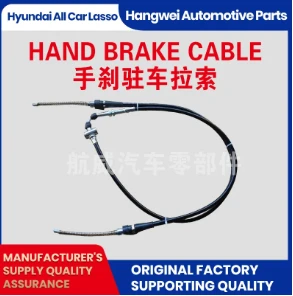clutch cable assembly
Understanding Clutch Cable Assembly A Key Component for Smooth Gear Shifting
The clutch cable assembly is an essential part of a manual transmission system that facilitates the smooth engagement and disengagement of the clutch, allowing for effective gear changes in vehicles. This crucial component plays a significant role in the performance and reliability of a vehicle's drivetrain.
What is a Clutch Cable Assembly?
At its core, the clutch cable assembly consists of a steel cable housed in a protective casing that connects the clutch pedal to the clutch mechanism. When the driver presses the clutch pedal, the cable pulls on the lever that disengages the clutch, permitting a clean shift between gears. Once the clutch pedal is released, the spring mechanism returns the clutch to its engaged position, allowing the engine's power to flow to the transmission.
Components of a Clutch Cable Assembly
1. Cable The primary component is the steel cable, designed to withstand high tensile strength. It is resistant to wear and tear, ensuring longevity and reliable performance over time.
2. Housing The cable is encased in a protective housing that prevents dust, dirt, and moisture from interfering with its operation. This housing also provides structural integrity to the cable, reducing friction during movement.
3. Mounting Brackets These fixed or adjustable brackets secure the cable assembly in place, ensuring it can function smoothly without any obstruction.
4. End Fittings The ends of the cable assembly are fitted with specific connectors that attach it to the clutch pedal and the clutch fork. These fittings must be robust and precisely engineered to withstand the forces exerted during operation.
The Importance of Proper Functioning
A well-functioning clutch cable assembly is vital for several reasons
clutch cable assembly

- Smooth Gear Shifting A malfunctioning cable can lead to difficult or imprecise shifting, making the driving experience frustrating and potentially unsafe.
- Preventing Wear on Other Components If the clutch cable does not operate smoothly, it can cause excessive wear on the clutch plate and other related components, leading to costly repairs.
- Safety A sensitive clutch cable enhances driver control over the vehicle. A failure in the system can lead to unintended gear changes or difficulty in stopping, which poses risks to the driver's safety and that of others on the road.
Signs of a Failing Clutch Cable Assembly
Drivers should be vigilant for signs that indicate potential problems with the clutch cable. Common symptoms include
- Stiff Clutch Pedal If the pedal feels unusually heavy or stiff when pressed, it might indicate a fraying or binding cable.
- Incomplete Disengagement If the gears grind while shifting, it could be a sign that the clutch isn't fully disengaging due to cable issues.
- Unusual Noises Strange sounds when operating the clutch can suggest that the cable or its fittings are worn out and require immediate attention.
Maintenance and Replacement
Regular inspection of the clutch cable assembly is essential for maintaining vehicle performance. Drivers should look out for any signs of wear or damage during routine maintenance checks. If problems are detected, replacing the clutch cable assembly with a high-quality part is imperative to ensure functionality and safety.
In conclusion, the clutch cable assembly is a vital component that plays a critical role in the operation of manual transmission vehicles. Ensuring its proper maintenance and timely replacement can elevate the driving experience, ensure safety, and enhance the overall longevity of the vehicle’s drivetrain. Understanding this component’s functions and signs of wear can empower drivers to take action and maintain their vehicles effectively.
-
Upgrade Your Control with Premium Throttle CablesNewsAug.08,2025
-
Stay in Control with Premium Hand Brake CablesNewsAug.08,2025
-
Experience Unmatched Performance with Our Clutch HosesNewsAug.08,2025
-
Ensure Safety and Reliability with Premium Handbrake CablesNewsAug.08,2025
-
Enhance Your Vehicle with High-Performance Clutch LinesNewsAug.08,2025
-
Elevate Your Ride with Premium Gear CablesNewsAug.08,2025
